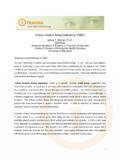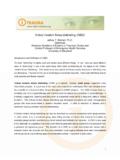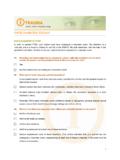Transcription of Critical Incident Stress Management - info …
1 Critical Incident Stress Management Jeffrey T. Mitchell, , Diplomate American Academy of Experts in Traumatic Stress and Clinical Professor of Emergency Health Services University of Maryland Critical Incident Stress Management (CISM) is a comprehensive, integrated, systematic and multi-component crisis intervention program. It was developed to help manage traumatic experiences within organizations and communities. CISM is a package of crisis intervention tactics that are strategically woven together to: 1) mitigate the impact of a traumatic event; 2) facilitate normal recovery processes in normal people, who are having normal reactions to traumatic events; 3) restore individuals, groups and organizations to adaptive function; and to 4) identify people within an organization or a community who would benefit from additional support services or a referral for further evaluation and, possibly, psychological treatment.
2 CISM is neither a form of psychotherapy, nor is it a substitute for psychotherapy. Instead, CISM is a broad collection of support services that can be selected and applied to assist people who are experiencing a strong reaction to a traumatic event. In other words, it is psychological first aid or emotional first aid . Similar to a toolbox with many tools for different purposes, CISM contains many crisis intervention tools . Some of those tools are useful before a traumatic event occurs. Others are useful while an event is ongoing. Still others are available for when the event is over. When it is researched, CISM should not be compared to psychotherapy or researched as if it were psychotherapy.
3 Researchers should be careful to research CISM as a package of interventions. None of the components of a CISM program have been designed to be used as standalone interventions. All CISM components should be part of a package of interventions. Additionally researchers should be careful to choose appropriate outcome measures. CISM cannot cure a disease or any mental disorder such as Post Traumatic Stress Disorder. CISM should be researched for what it is and for its intended purposes, and not for outcomes that are well beyond its scope. A CISM program is comprehensive, in that it: promotes pre-event Stress and crisis Management education; planning and policy development; as well as training and preparations for the Management of traumatic Stress .
4 The program also contains a set of interventions which are helpful for when a traumatic event is in progress. Finally, The CISM package has interventions that are useful in the aftermath of a traumatic event. It is integrated in that the components of a CISM program are linked and blended together into a cohesive approach for use in crisis intervention. When the word systematic is used, it means that the elements of a Critical Incident Stress Management program are applied in a logical, step-1 by-step manner. For example, after a traumatic event individual support processes may precede small group crisis interventions, and then the small group interventions may be followed up with additional individual sessions, referrals (if necessary) or post Incident educational programs, etc.
5 Multi-component means that a CISM program has many parts that are interlocked. It encourages a strategic, multi-faceted and interlinked approach to crisis Management . CISM has its roots in the crisis intervention theory and practices of the last century. It is based upon four main foundational building blocks. They are: a) crisis intervention; b) group psychotherapy; c) community psychology; and d) peer support. Notable theorists and practitioners who helped develop the core principles that form the foundations of current day CISM services include Eric Lindemann, Gerald Caplan, Howard Parad, and Irvin Yalom. Although not called CISM until the mid 1980s, Critical Incident Stress Management concepts were introduced into the emergency services field in 1974.
6 They were first developed to assist emergency operations personnel, such as police officers, firefighters, emergency medical and military personnel. Over the last three decades CISM support services have extended well beyond their original intended target populations and now include school systems, the business sector, church groups and the industrial main components of a Critical Incident Stress Management (CISM) program include, but are not limited to, the following: Pre- Incident planning, policy development, education, training Crisis assessment Strategic planning Individual crisis intervention Large group interventions (Demobilization, Crisis Management Briefing) Small group crisis interventions (Defusing, Critical Incident Stress Debriefing {CISD})
7 Pastoral crisis intervention Family support services Significant other support services Follow-up services Referral services Follow-up meetings Post- Incident education Links to pre- Incident planning and preparation for the next crisisAlthough there are relatively few CISM studies, the research that has been conducted to date, respecting Critical Incident Stress Management , has yielded consistently positive results. When several CISM interventions are blended together the results are much stronger than when individual features are studied in isolation. Specific references for the CISM studies are shown References Boscarino, , Adams, & Figley, (2005).
8 A Prospective Cohort Study of the Effectiveness of Employer-Sponsored Crisis Interventions after a Major Disaster. International Journal of Emergency Mental Health, 7(1), 31-44. Caplan, G. (1961). An approach to Community Mental Health. New York: Grune and Stratton Caplan, G. (1964). Principles of Preventive Psychiatry. New York: Basic Books. Caplan, G. (1969). Opportunities for school psychologists in the primary prevention of mental health disorders in children, In A. Bindman and A. Spiegel (Eds.) Perspectives in Community Mental Health ( ). Chicago: Aldine. Chemtob, C., Tomas, S., Law, W. & Cremniter, D. (1997). Post disaster psychosocial intervention.
9 American Journal of Psychiatry, 134, 415-417. Deahl, M., Srinivasan, M., Jones, N., Thomas, J., Neblett, C. & Jolly, A. (2000). Preventing psychological trauma in soldiers. The role of operational Stress training and psychological debriefing. British Journal of Medical Psychology, 73, 77-85. Everly, , Jr. and Mitchell, (1999). Critical Incident Stress Management : A new era and standard of care in crisis intervention, second edition. Ellicott City, MD: Chevron Publishing Corp. Flannery, R. B. (1998). The Assaulted Staff Action Program. Ellicott City, MD: Chevron. Flannery, R. B., Fuleron, P., Trausch, J., & DeLoffi, A. (1991) A Program to help staff cope with psychological sequelae of assaults by patients.
10 Hospital and Community Psychiatry, 42, 935-938. Hokanson, M. (1997) Evaluation of the Effectiveness of the Critical Incident Stress Management Program for the Los Angeles County Fire Department. Los Angeles, CA: LACoFD. Jenkins, S. R. (1996). Social support and debriefing efficacy among emergency medical workers after a mass shooting Incident . Journal of Social Behavior and Personality 11, 447-492. Lindemann, E. (1944). Symptomatology and Management of acute grief. American Journal of Psychiatry, 101, 141-148. Mitchell, J. T. (1983). Effects of Stress Management Training on Paramedic Coping Styles and Perceived Stress Levels (Doctoral Dissertation). Ann Arbor, MI: University Microfilms International.






